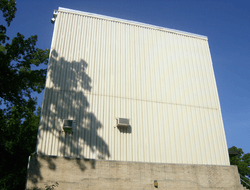Missouri University of Science and Technology Nuclear Reactor
| MSTR | |
|---|---|
 | |
| Operating Institution | Missouri University of Science and Technology |
| Location | Rolla, Missouri |
| Coordinates | 37°57′16″N 91°46′21″W / 37.95454°N 91.77248°WCoordinates: 37°57′16″N 91°46′21″W / 37.95454°N 91.77248°W |
| Type | Pool |
| Power | 200 kW (Thermal) |
| First Criticality | 1961 |
| Technical Specifications | |
| Fuel Type |
plate type (19x) 9-18 per assembly |
| Cooling | Light water |
| Neutron Moderator | Light water |
| Control Rods | boron & stainless steel (4x) |
| Source(s): [1] | |
The Missouri University of Science and Technology Nuclear Reactor (MSTR or Missouri S&TR) is a pool-type nuclear reactor operated by the Missouri University of Science and Technology (Missouri S&T). It first achieved criticality in 1961, making it the first operational nuclear reactor in the state of Missouri.[2] Missouri S&T operates this reactor for training, education, and research purposes.
Specifications
The reactor core is situated inside a standing pool of high-purity light water on a grid plate suspended from a movable rail bridge. The pool holds 32 thousand US gallons (120 m3) of this water in a concrete casing that is 19 by 9 feet (5.8 m × 2.7 m) at the base with a depth of 27 to 30 feet (8.2 to 9.1 m). The approximately 19 fuel elements contain between nine and 18 low-enriched uranium fuel plates. The reactor has a maximum power output of 200 kilowatts. This is all thermal energy, and none of it is used to make electricity.[1]
The reactor uses a total of four control rods. Three of these control rods are used for coarse power control and emergency SCRAM shutdowns, and utilize a combination of stainless steel and boron. The other control rod is used for fine power control, and simply uses stainless steel.[1]
The building houses several experimental facilities. These facilities are used for research and for classroom lab activities. A thermal column, consisting of a 3.5×3.5×5 feet (1.1×1.1×1.5 m) block of graphite, provides a source of slow neutrons. A 6 inches (150 mm) diameter aluminum tube, called a beam port, can be positioned between the reactor core and an experimental area in the ground floor of the reactor building, allowing irradiation of a sample with higher energy neutrons. Other facilities, called rabbits, are used to pneumatically inject a sample directly into the core of the reactor for a specified amount of time. One of the rabbit facilities is lined with cadmium in order to stop low-energy neutrons while allowing bombardment of the sample with high-energy neutrons.[3]
Outreach
Missouri S&T's nuclear engineering department is involved in outreach programs to rising high school juniors, seniors, and college freshmen, such as its summertime Nuclear Engineering Camp. The camp involves tours of the Missouri S&T reactor, as well as several focused areas of study and lab experiments related to nuclear engineering.[4]
References
- 1 2 3 "General Facts and Information about Missouri S&TR". Missouri University of Science and Technology. Retrieved 2008-06-29.
- ↑ "Missouri Nuclear Industry". Energy Information Administration. 2006-08-18. Retrieved 2008-06-29.
- ↑ "Missouri S&T Nuclear Reactor". Missouri University of Science and Technology. Retrieved 2008-06-29.
- ↑ "Nuclear Engineering Camp". Missouri University of Science and Technology. Archived from the original on 2008-08-04. Retrieved 2008-06-29.